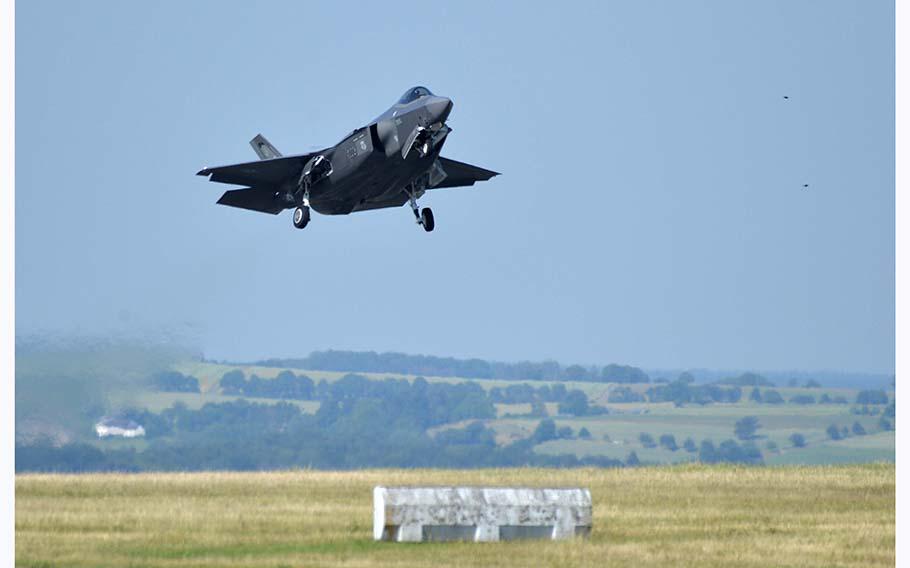
An F-35 Lightning II from the 158th Fighter Wing of the Vermont Air National Guard takes off from Spangdahlem Air Base, Germany, on June 14, 2023, during the German-led allied exercise Air Defender 23. (Michael Abrams/Stars and Stripes)
SPANGDAHLEM AIR BASE, Germany — The repeated, ear-numbing rumble of American fighter jets from three squadrons shook the countryside around this base in Germany’s rural Eifel region Wednesday.
Barreling down the runway throughout the day were F-35s visiting from Vermont and F-16s hailing from Minnesota, as well as Spangdahlem’s own Fighting Falcons.
They flew as part of Air Defender, a German-led exercise involving the most aircraft working together in European skies in the history of NATO. It’s the largest showcase of airpower from NATO and partner nations in more than 70 years.
“The scope and scale of this exercise cannot be underestimated,” said Col. Daniel Finnegan, commander of the 158th Fighter Wing of the Vermont Air National Guard.
Having hundreds of aircraft from more than 20 countries launch from numerous bases to achieve a specific objective is daunting, he said.
The exercise also is a good opportunity to practice getting across the Atlantic Ocean quickly and efficiently, and the wing is “exploring faster ways for us to get out of the East Coast … (with) less tanker support,” Finnegan said.
For security reasons, he didn’t disclose how many F-35s deployed to Spangdahlem, but about 100 personnel from the Vermont Air National Guard accompanied the aircraft, officials said.
The 10 days of drills are being staged amid the Russia-Ukraine war, which began with an unprovoked, full-scale invasion by Russian forces on Feb. 24, 2022.
In the past two weeks, Ukraine has reported recapturing territory during a counteroffensive supported by billions of dollars in military aid from the United States and its partners and allies.
Air Defender has been in the works since 2018, a few years after Russia illegally annexed Crimea from Ukraine.
“The exercise is a signal, a signal above all to us … the NATO countries, but also to our population that we are in a position to react very quickly … that we would be able to defend the alliance in case of attack,” German air force chief Lt. Gen. Ingo Gerhartz told ZDF television Monday.
Participants are simulating defense of the Baltic Sea coast and practicing protection of cities, ports and airports in the designated training areas, most of which are in Germany, Gerhartz said in his television interview.
Scenarios to be practiced revolve around Article 5, which calls for all NATO countries to respond when one member comes under attack.
But for the American fighter pilots involved in Air Defender, some of whom likely would be called on if Article 5 was invoked, the focus is more on teamwork.
“This is all about relationship-building,” said Lt. Col. Nathaniel Hofmann, who commands the 52nd Operations Support Squadron at Spangdahlem. “Anytime you go into a complex environment, confusion is inherent, so the more that we can put ourselves in these scenarios in peacetime, (the easier) we’re going to be able to do it when called upon.”
Relationships also were being forged on the ground. Guard troops from Vermont showed members of the German air force an F-35 parked inside a hardened aircraft shell at Spangdahlem on Wednesday, pointing out some of the plane’s features.
The F-16s from Spangdahlem are practicing their “bread and butter,” the suppression of enemy air defenses, said Capt. Tyler Knickerbocker, a pilot with the 480th Fighter Squadron.
The “Wild Weasels” are usually “the first ones into a contested area, and we’re usually going to be the last ones out,” he said, adding their singular focus is on destroying any potential ground threats.